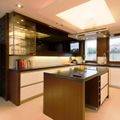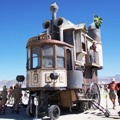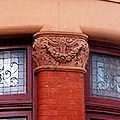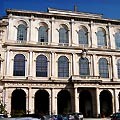
In Weak Housing Market, Some Homeowners Investing in Green
It’s a tough housing market. The nation is awash in anxiety over mortgage defaults, credit problems, debate over bailouts and haggling over the future of Fannie Mae and Freddie Mac.
People are staying in homes longer, rather than flipping houses, and they are now investing in their houses and buying bigger-ticket items. In a trend that at first seems counterintuitive given the weak housing market, many homeowners are spending considerable amounts of money in green building features, such as energy efficiency upgrades and non-toxic products.
More and more builders, designers, real estate agents and homeowners are discovering that going green can help them get a leg up in tough times, as well as substantially decrease our environmental footprints, from carbon emissions to water and land use. As more wealthy homeowners invest in green building, prices keep coming down, and trends percolate down to the middle classes — and eventually to low-income residences as well.
Fortunately for green, many of those new bigger-ticket items boast impressive eco-friendly advantages. Some of the hot green design trends include original antiques (which is a time-tested way of recycling), organic, non-toxic paints, wallpaper and upholstery, energy efficient appliances and countertops made of poured concrete or “lavastone,” instead of mining and energy-intensive granite.
Here are 5 Simple Money-Saving Green Remodeling Ideas:
1. Dodge Drafts and Seal Air Leaks
Perhaps one of the easiest ways to save money around the house is to seal off drafts, which can reduce your energy bills 5 to 30 percent, according to the U.S. Department of Energy.
2. Install a Programmable Thermostat
It may not be the most thrilling piece of electronics you could buy yourself, but a programmable thermostat will pay for itself in one season, and save you time and hassle.
3. Fix Those Water Leaks
A dripping faucet or pipe joint can really add up to substantial water waste. One faulty faucet wastes 3 gallons of water per day, reports the U.S. Geological Survey.
4. Install Low-Flow Showerheads and Toilets
It’s a fact that most older models waste large amounts of water. In fact, more than 30 percent of indoor residential water use is flushed down the porcelain throne.
5. Buy Energy Star Appliances
Look for the blue-and-white label, which means the item is at least 10 to 50 percent more efficient than standard models. That means lower energy bills and less pollution.
Full Post

Kitchen Trends for 2012
Remodeling your kitchen is a great way to add function and appeal, while increasing the overall value of your home. You may choose to build new kitchen cabinets and countertops or reface the old ones. Plan carefully for a kitchen design that will not only look great, but will also maximize space and efficiency.
My wife and I have just completed the remodeling of our kitchen. Like most people, we got inspiration from several sources and kept on top of the latest and greatest. Most people like clean lines and neutral colors in their kitchens, they want what is safe for resale and at the same time unique from their neighbors. It seems contradictory, but people want to be unique while at the same time they are doing exactly what everyone else is doing.
Trends in kitchen design are sometimes considered temporary fads. However, if you look deeper there are trends that are consistent and are here to stay. The Big Three of the classic looks are Still Big: Granite countertops, stainless steel appliances and wood floors have always been favorites for a trendy kitchen.
Here is my list of kitchen trends for 2011 in a nutshell, taken from disparate sources:
Curved shapes: The way to introduce curved shapes and impart the kitchen with a modern look is through the introduction of rounded sinks, curved islands and curved faucets.
Materials and styles: Mix and match materials to impart a unique look. For example mix materials such as wood and glass. You can also design the cabinets and the island of different materials.
Artistic details: Replace the straight cabinet handles with curved handles featuring any design. The faces of cabinets and drawers can also be detailed with artistic design.
Vibrant countertops: Use flaunt punchy colors and showy surfaces. For example use glazed blue lava stone for the countertop against turquoise glass tiles for the backsplash.
Maximum Preparation Space: Island/peninsula combinations, table islands, dual islands and tiered islands leave plenty of room in the kitchen for meal preparation, storage and dining.
Functional Storage Space: Pullouts make it easy to organize your pots, pans, dishes and bake ware. A pullout pantry is a great way to organize your dry and canned goods.
“Niche” Appliances: There’s an appliance for almost any task these days: small refrigerators, drawer dishwashers, wine coolers, trash compactors, and warming drawers are just a few.
Going Green: The easiest way to aid the environment is by using Energy Star appliances. Choose a “green kitchen” featuring sustainable products, such as bamboo floors, recycled glass, etc.
A Splash with a Backsplash: The purpose of a backsplash is to protect your kitchen walls from stains. However, it may also be used to give your kitchen a more elegant look. Glass tiles are becoming more and more popular in the kitchen this year.
Crown Molding: When you add crown molding to your kitchen, it will give it a more finished look to your cabinetry, as well as a little more architectural appeal to your space.
Combining Rooms: You may want to consider tearing down a wall separating your kitchen from the dining room. This will open up your kitchen space and make you home more functional.
Lighting under the Cabinets: Compact florescent and LED lights are incredibly energy efficient and easy to install under the cabinets in your kitchen to accent, brighten, and illuminate.
Tailored Storage Solutions: The kitchen is the center of the home, so your time here should work for your needs. It is critical to inventory everything before you design your dream kitchen.
Chef convenience: With all the cooking shows on TV, it is easy to see how the trend for restaurant equipment continues to rise. While the impressive stainless steel look is a driving factor, convenience is often the winning key.
Pendant Lighting: Whether over an island, or a nearby breakfast nook, pendant lighting is eye candy! Lighting can give a sculptural boost, aid in focal points, and give the most ideal lighting for tasks.
Open it Up: The most interesting designs include open shelving. They offer a break to the boxy monotony of a standard kitchen design, and allow the design to breathe. A mix of cabinets, glass doors and open shelves provide the best design balance.
Note: By the way, if you’re planning a kitchen change and live in the Los Angeles Area, then I highly recommend a call to “House of Décor” (818-787-3339) for a free estimate. They’ve done an outstanding job with our kitchen cabinets, providing an all-inclusive service (demolition, cabinets, countertop and installation) for the lowest price around.
Full Post

The Never Was Haul (Berkeley, California, USA)
Inspired by the work of Jules Verne, the Neverwas Haul is a fantastic steam-powered, mobile 3 story Victorian mansion that was constructed for Burning Man 2006 by a team of industrious lunatics.
Full Post

Kerala House Boats (Kerala, India)
Kerala Houseboats (Riceboats) are country boats that were used in the early days for the transport of goods from the isolated interior villages of Kerala Backwater area. With the advent of roads, bridges and ferry services, gradually the kettuvalloms went off the scene. Now these kettuvalloms are back again as a major tourist attraction as a modern moving boat.
The materials that go into the making are all local and Eco friendly bamboo poles, coconut fiber ropes, bamboo mats, etc. The main wood used is “Anjili”.
Full Post

Festoon
A Renaissance ornament of fruit and vines with leaves that hang between or drape down from a rosette or carved head.
Full Post

Fenestration
Derived from the French word fenêtre. It describes the layout of the windows. In medieval times when glass was scarce, this described the layout of wooden panels used to shutter the windows.
Full Post

Fanlight
A window over the door that is curved or shaped like a fan. A transom is the rectangular version of the fanlight.
Full Post

Cass Gilbert (1859 – 1934)
Best known for his Gothic Revival skyscraper, the Woolworth Building, Cass Gilbert had enormous influence on the development of architecture in the United States.
Although Cass Gilbert’s name is rarely mentioned today, he exercised enormous influence on the development of architecture in the United States. He is perhaps best known for his Gothic Revival skyscraper, the Woolworth Building, which was the world’s tallest building at the time. Combining modern technologies with historic ideas, Gilbert designed many public buildings. He was a consulting architect for the George Washington Bridge, which crosses the Hudson River in upper Manhattan, New York City.
Cass Gilbert was highly regarded by politicians and other luminaries of the day. President Theodore Roosevelt made him chairman of the Council of Fine Arts, and President Wilson reappointed him. Gilbert received many gold metals in the United States and Europe.
By the 1950s, Gilbert’s name slipped into obscurity. Modernism, which idealized sleek, unornamented forms, became fashionable and Gilbert’s buildings were often dismissed or ridiculed. Today, however, a new appreciation for architecture based on historic themes has reawakened interest in his work.
Notable Buildings:
1900: Broadway Chambers Building, New York City
1902: Essex County Courthouse, Newark, New Jersey
1905: Minnesota State Capitol, St. Paul
1907: US Custom House, New York City
1913: Woolworth Company Building, New York City
1917: Allen Memorial Art Museum at Oberlin
Full Post

Bruce Graham (1925 – 2010)
A leading architect for Skidmore, Owings & Merrill, Bruce Graham transformed Chicago’s skyline, designing some of the City’s most famous skyscrapers.
Bruce Graham was considered one of America’s leading designers of high-rise buildings. Although he never studied with Mies van der Rohe, he was instrumental in applying “Miesian” ideas to Chicago’s skyscrapers. Most significantly, Graham used the tubular frame principle for several important buildings.
After the 1970s, America began to look less favorably on stark architecture in the Mies van der Rohe style. Graham’s designs became more complex with greater detail.
Bruce Graham has served as a general partner at Skidmore, Owings & Merrill (SOM) for most of his career. In addition to his famous skyscrapers, Bruce Graham helped create the 1973 urban plan for Chicago.
Notable Buildings:
1974 to 1976: Willis Tower (Originally the Sears Tower), Chicago, Illinois
1974: First Wisconsin Plaza, Madison, Wisconsin
1970: John Hancock Center, Chicago, Illinois.
Full Post

A (very brief) Guide to London
London, the capital of England and the United Kingdom, was founded 2000 years ago by the Romans as Londinium. The city has been Western Europe’s largest city for centuries: as early as in 1700 more than 575,000 people lived in London.
Today London is not only the largest city but also one of the most visited thanks to its numerous famous attractions such as the Tower Bridge and the Big Ben.
Predominant Architecture:
The city of London is not characterized by any particular architectural style, having accumulated its buildings over a long period of time. Few structures predate the Great Fire of 1666, notable exceptions including the Tower of London, Westminster Abbey, Banqueting House and several scattered Tudor survivors in the City of London.
Places to See:
Big Ben: The Clock Tower of the Palace of Westminster, known as the Big Ben, is one of London’s most famous landmarks. At the time the tower was built in 1858 its clock was the largest in the world.
Tower Bridge: Despite being disliked by many when it was built in 1894 the bridge soon became one of the London’s most famous landmarks.
London Eye: A giant observation wheel in the center of London. Since its opening in 2000 the 30-minute ‘flight’ offers visitors great panoramic views over London.
Houses of Parliament: The seat of Britain’s two parliamentary houses was built in 1870. The enormous building is best known for its iconic clock Tower, the Big Ben.
Westminster Abbey: Construction of the Westminster Abbey started in 1050 and spanned 8 centuries. The abbey serves as a burial ground for many famous monarchs, scientists and artists.
Buckingham Palace: The most famous of all the palaces in London. The palace is still used as the official residence of the Queen.
Full Post

A (very brief) Guide to Vancouver
Vancouver is a very young city; it wasn’t until after the World Exposition in 1986 before Vancouver changed from a sleepy provincial city to a booming metropolis.
Even today the city continues to expand at a high rate: once abandoned industrial areas have thus turned into fashionable and lively districts such as Yaletown and Coal Harbour.
Predominant Architecture:
Vancouverism is a term that refers to tall, but widely separated, slender towers interspersed with low-rise buildings, public spaces, small parks and pedestrian-friendly streetscapes and facades to minimize the impact of a high density population.
However, Vancouverism is more of an architectual technique rather than style. Vancouver’s predominent style is Neomodernism, which shares many of the basic characteristics of modernism.
Places to see:
Chinatown: Vancouver’s Chinatown is one of the largest in North America. The neighborhood’s main attraction is the beautiful Dr. Sun-Yat-Sen garden, an authentic Chinese garden.
Gastown: Named after the saloon proprietor Gassy Jack Deighton, is the area where Vancouver was founded in 1867. The historic area is especially popular with tourists.
Granville Island: In the 1970s this former industrial site was turned into a recreational and entertainment area. The popular island is best known for its indoor public market.
Canada Place: One of Vancouver’s main landmarks, originally built for the 1986 World Exposition. The building is now mainly used as a convention center.
Stanley Park: A 1000-acres large park on a peninsula bordering downtown Vancouver. This forest-like park, surrounded by the ocean, comprises many recreational areas.
Robson Street: Vancouver’s main retail strip, ideal for shopping and dining. Some of the city’s attractions are located here, such as the Art Gallery and the modern library building.
Full Post

A (very brief) Guide to Stockholm
Stockholm, the largest city in Scandinavia, has a surprisingly large number of interesting sights, with plenty of palaces and monuments that are reminiscent of a time when the Swedish empire was one of Europe’s largest powers.
The city is defined by its location on a large archipelago, and it is spread over 14 islands. The abundance of water and the many riverboats have given Stockholm the name ‘Venice of the North’.
Predominant Architecture:
Stockholm has a history that dates back to the 13th century, possibly even longer. Most major buildings were mainly designed by influences from abroad. During 1600 and 1700, foreign architects were recruited to build the city and in recent periods Swedish architects often drew on their inspiration from their study tours to Europe, in the 20th century, particularly in the USA.
Stockholm’s historic buildings are largely conserved, possibly because the city escaped destruction by war, suffered by so many other cities in Europe.
Places to see:
Gamla Stan: The Old Town of Stockholm. The area, with its picturesque squares and cobblestone alleys is a favorite with visitors. Many of Stockholm’s top sights can be found here.
Royal Palace: Kungliga Slottet is a large Baroque palace built in the early 18th century at Gamla Stan. Every day during summertime crowds gather here to watch the Changing of the Guards.
Vasa Museum: The Vasa, a historic warship decorated with hundreds of statues, sank on its maiden voyage in 1628. It was salvaged in the mid 20th century and is now displayed in its own purpose-built museum.
Drottningholm Palace: The official residence of Sweden’s royal family. Built at the end of the 17th century in a Baroque style, it was one of the most magnificent palaces of its time.
Stadshuset: Stockholm’s city hall is one of Sweden’s most important 20th century buildings. It has a magnificent interior; its Golden Hall is decorated with gilded Byzantine mosaics.
Storkyrkan: The cathedral of Stockholm has a Gothic interior dating back to the 15th century. Inside is a unique wooden statue of St. George and the Dragon.
Strandvägen: Stockholm’s most impressive boulevard is lined with grand, monumental buildings that were designed during the 19th century by some of the best architects of the time.